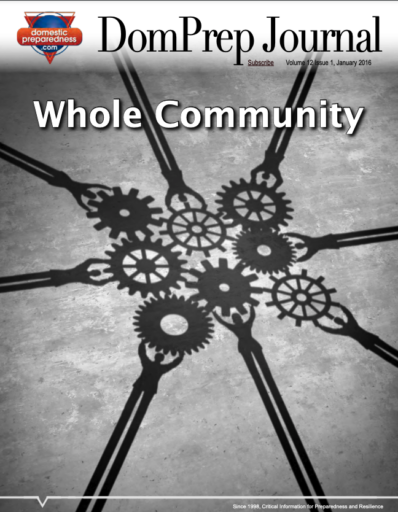

Development of Metrics for Personal Preparedness
Shannan Saunders, Jeff Hayes, Daniel Ellis, Dolph Diemont, Megan Chamberlain, Bruce Lockwood, Randy Robertson and Meloyde Batten-Mickens
January 27, 2016
Many emergency management agencies provide valuable information to assist individuals within their communities to prepare for a variety of disasters. However, a method for measuring the success of such programs is needed to determine their effectiveness and to develop new programs to ensure community resilience.

What the ‘Whole Community’ Means to the Whole Community
Richard Serino and Jennifer Grimes
January 27, 2016
Disaster response involves the whole community. To support a united effort, leaders must build a network of trust, establish a history and habit of cooperation, and learn the goals and vulnerabilities of stakeholders. By asking a few key questions, leaders can expand the sphere of their preparedness, response, and recovery efforts.

Whole Community – A Five-Year Look Back
Catherine L. Feinman
January 27, 2016
Over the past five years, the term “Whole Community” has become a common catch phrase. However, the
question is, “How well is this concept being implemented?” On 16 November 2015, DomPrep hosted a
roundtable discussion with subject matter experts to answer this question and share key takeaways and
suggestions for building community resilience.

Four Steps to Improve Whole Community
Vincent B. Davis
January 20, 2016
The whole community concept has come a long way over the past five years, but it is time for the mission focus and community outreach to change with the changing needs of the target populations. To effectively make these changes, the effort will require establishing measurable benchmarks and creatively collaborating with the private sector.

Bleeding Control – The Next Step in Active Shooter Guidance
Birch X. Barron
January 20, 2016
Military methods used for bleeding control on the battlefield can be just as effective on the scene of an active shooter, terrorist attack, or other mass casualty incident. It is time to teach these methods to anyone who may someday find himself or herself in a position to save a life by stopping the bleed.

Animals as Part of the Whole Community
Anne McCann and Richard Green
January 20, 2016
Animal issues are people issues. As such, all species household pets, service and assistance
animals, agricultural animals/livestock, wildlife, and other animals (including zoo animals, shelter
animals, and animals used in medical research) – must be an integral part of a community’s disaster plan
at the local, state, and federal levels.

Building a Usable Whole Community Toolbox
Robert deLeon
January 20, 2016
Having a toolbox with the right tools and instructions on how to use these tools would better equip
new emergency managers who may be faced with high levels of operation in short time periods. Community
stakeholders and local emergency managers should work together to stock the emergency management toolbox
for the next generation.

The Whole Community Paradigm Shift
Anthony S. Mangeri
January 13, 2016
Over the years, communities developed a dependence on the federal government for assistance following a disaster. However, such actions are not sustainable and require the support of partners throughout each community. In the modern threat environment, the need for a whole community approach is more important than ever.

Ignoring Spontaneous Volunteers – Not an Option
Chelsea Firth
January 13, 2016
Managing spontaneous volunteers following a disaster can be challenging, but may prove beneficial for a community’s response and recovery efforts. A new project is being conducted throughout 2016 to create an outreach and education strategy for harnessing this valuable resource.

Innovations in Healthcare Disaster Management for Veterans
Jessica Wambach Brown
January 12, 2016
Although fewer than 40 percent of U.S. veterans receive care through the U.S. Department of Veterans Affairs (VA), the agency strives to have broad access to reliable medical care during a disaster. The Veterans Emergency Management Evaluation Center and its partners are exploring ways to improve healthcare resilience both inside and outside the VA.

